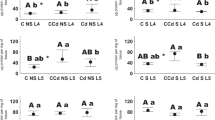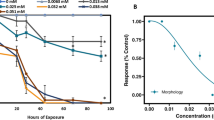Abstract
We evaluated the toxicity of CdCl2, HgCl2, and MeHgCl on the C6/36 cell line of Aedes albopictus. This cell line proved to be a suitable tool for studying heavy-metal toxicity in insect cells. Since data on heavy-metal toxicity in invertebrate cell cultures are almost nonexistent, our results are discussed in relation to in vivo invertebrate and in vitro vertebrate studies. Viability and proliferation were assessed by dye exclusion and DNA quantification, respectively. Viability tests were carried out with and without 5% fetal calf serum in the medium. The three metal species decreased viability to different extents (MeHgCl>HgCl2>CdCl2), and fetal calf serum had a protective effect. In serum-deprived cultures, LD50 values were 140.20, 2.51, and 2.08 µmol/L for CdCl2, HgCl2, and MeHgCl, respectively. For cultures with fetal calf serum, LD50 values were 149.71, 12.01, and 5.47 µmol/L, respectively. The viability curve for CdCl2 under serum-free conditions suggests the induction of a cell defense system. The three metal species also inhibited cell proliferation (MeHgCl> CdCl2> HgCl2). The IC50 values were 1.75, 18.36, and 0.96 µmol/L for CdCl2, HgCl2, and MeHgCl, respectively. In summary, low MeHgCl concentrations caused both cell death and inhibition of cell proliferation; HgCl2 primarily disrupted the plasma membrane, whereas CdCl2 primarily inhibited cell proliferation.
Similar content being viewed by others
References
Aleo MD, Taub ML, Kostyniak PJ. Primary cultures of rabbit renal proximal tubule cells. III. Comparative cytotoxicity of inorganic and organic mercury. Toxicol Appl Pharmacol. 1992;112:310–7.
Bauman JW, Liu J, Klaassen CD. Production of metallothio-nein and heat-shock proteins in response to metals. Fundam Appl Toxicol. 1993;21:15–22.
Blazka ME, Shaikh ZA. Differences in cadmium and mercury uptakes by hepatocytes: role of calcium channels. Toxicol Appl Pharmacol. 1991;110:355–63.
Blazka ME, Yoshida M, Shaikh ZA. Comparison of cadmium, mercury and calcium accumulations by isolated hepatocytes of the small skate (Raja erinacea) and rat. Comp Biochem Phys C. 1992;101(3):631–9.
Borowitz JL, McLaughlin JL. Evidence for calcium channels in brine shrimp: diltiazem protects shrimp against cadmium. Bull Environ Contam Toxicol. 1992;48:435–40.
Chin TA, Templeton DM. Protective elevations of glutathione and metallothionein in cadmium-exposed mesangial cells. Toxicology. 1993;77:145–56.
Christensen MM, Ellermann-Eriksen S, Rungby J, Mogensen SC. Comparison of the interaction of methyl mercury and mercuric chloride with murine macrophages. Arch Toxicol. 1993;67:205–11.
Clarkson TW. Molecular and ionic mimicry of toxic metals. Annu Rev Pharmacol Toxicol. 1993;32:545–71.
Corrigan AJ, Huang PC. Cellular uptake of cadmium and zinc. Biol Trace Elem Res. 1981;3:197–216.
Embrey KJ, Searle MS, Craik DJ. Interactions of Hoechst 33258 with the minor groove of the A+T-rich DNA duplex d(GGTAATTACC)2 studied in solution by NMR spectro-scopy. Eur J Biochem. 1993;211:437–47.
Fang SC, Fallin E. The binding of various mercurial com-pounds to serum proteins. Bull Environ Contam Toxicol. 1976;15(1):110–7.
Igarashi A. Isolation of a Singh's Aedes albopictus cell clone sensitive to dengue and chikungunya viruses. J Gen Virol. 1978;40:531–44.
Kitamura S. The in vitro cultivation of tissues from mosquitos. Kobe J Med Sci. 1966;12(1):63–70.
Kowalczyk JK, Watala C. Content of some heavy metal ions in various developmental stages of the social wasp, Dolichove-spula saxonica (Fabr.)(Hymenoptera, Vespidae). Bull Envir-on Contam Toxicol. 1989;43:415–20.
Labarca C, Paigen K. A simple, rapid, and sensitive DNA assay procedure. Anal Biochem. 1980;102:344–52.
Lin RH, Lee CH, Chen WK, Lin-Shiau SY. Studies on cytotoxic and genotoxic effects of cadmium nitrate and lead nitrate in Chinese hamster ovary cells. Environ Mol Muta-gen. 1994;23:143–9.
Miura K, Suzuki K, Imura N. Effects of methylmercury on mitotic mouse glioma cells. Environ Res. 1978;17:453–71.
Miura K, Nakada S, Suzuki K, Imura N. Ultrastructural studies on the cytotoxic effects of mercuric chloride on mouse glioma. Ecotoxicol Environ Safety. 1979;3:352–61.
Nakada S, Inoue K, Nojima S, Imura N. Change in permeability of liposomes caused by methylmercury and inorganic mercury. Chem Biol Interact. 1978;22:15–23.
Nieminen A-L, Gores GJ, Bond JM, Imberti R, Herman B, Lemasters JJ. A novel cytotoxicity screening assay using a multiwell fluorescence scanner. Toxicol Appl Pharmacol. 1992;115:147–55.
Perrino BA, Chou I-N. Role of calmodulin in cadmium-induced microtubule disassembly. Cell Biol Int Rep. 1986;10(7):565–73.
Planas-Bohne F, Klug S. Uptake of cadmium into cells in culture. Toxicol Environ Chem. 1988;18:229–38.
Repetto G, Sanz P, Repetto M. In vitro effects of mercuric chloride and methylmercury chloride on neuroblastoma cells. Toxicol In Vitro. 1993;7(4):353–7.
Roy C, Prasad KVS, Reuhl KR, Little JE, Valentine BK, Brown DL. Taxol protects the microtubules of concanavalin A-activated lymphocytes from disassembly by methylmercury, but DNA synthesis is still inhibited. Exp Cell Res. 1991;195:345–52.
Shenker BJ, Berthold P, Decker S et al. Immunotoxic effects of mercuric compounds on human lymphocytes and mono-cytes. II. Alterations in cell viability. Immunopharmacol Immunotoxicol. 1992;14(3):555–77.
Shenker BJ, Berthold P, Rooney C, Vitale L, DeBolt K, Shapiro IM. Immunotoxic effects of mercuric compounds on human lymphocytes and monocytes. III. Alterations in B-cell function and viability. Immunopharmacol Immunotoxicol. 1993;15(1):87–112.
Singh KRP. Cell cultures derived from larvae of Aedes albopic-tus (Skuse) and Aedes aegypti (L.). Curr Sci. 1967;19:506–8.
Singhal RK, Anderson ME, Meister A. Glutathione, a first line of defense against cadmium toxicity. FASEB J. 1987;1:220–3.
Smith JB, Smith L, Pijuan V, Zhuang Y, Chen Y-C. Transmem-brane signals and protooncogene induction evoked by carcinogenic metals and prevented by zinc. Environ Health Perspect. 1994;102(supplement 3):181–9.
Thrasher JD, Adams JF. The effects of four mercury com-pounds on the generation time and cell division in Tetra-hymena pyriformis,WH14. Environ Res. 1972;5:443–50.
Vallee BL, Ulmer DD. Biochemical effects of mercury, cad-mium, and lead. Annu Rev Biochem. 1972;41:91–128.
Walton BT. Insects as indicators of toxicity, bioaccumulation and bioavailability of environmental contaminants. Environ Toxicol Chem. 1989;8:649–58.
Weast RC. Handbook of chemistry and physics. 52nd edition. Cleveland, OH: Chemical Rubber Company; 1971.
Author information
Authors and Affiliations
Rights and permissions
About this article
Cite this article
Braeckman, B., Raes, H. & Van Hoye, D. Heavy-metal toxicity in an insect cell line. Effects of cadmium chloride, mercuric chloride and methylmercuric chloride on cell viability and proliferation in Aedes albopictus cells. Cell Biol Toxicol 13, 389–397 (1997). https://doi.org/10.1023/A:1007425925726
Issue Date:
DOI: https://doi.org/10.1023/A:1007425925726




